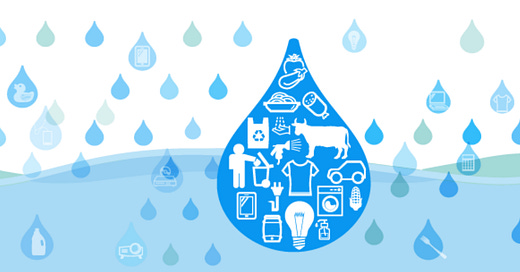There’s an increasing awareness of our carbon footprint, which is an estimate of the amount of greenhouse gases (e.g., carbon dioxide and methane) that are emitted due to the consumption of fossil fuels from our activities. Each of us has a carbon footprint, which can be estimated by examining our daily habits. For example, if we drive to work, our carbon footprint will be higher than if we rode a bicycle.
A lesser-known metric to help us understand our impact on the planet is known as Virtual Water, which is defined as the water used to produce the goods and services that we use.
You may currently get a monthly or bi-monthly water bill, which will provide you with data on your water consumption. Every time you turn on the tap, take shower or flush the toilet, you are consuming water that will be reflected on your water bill. Government data shows that in Ontario, the average daily residential use per capita of the population served is around 300 litres per day.
But we use a lot more water than the water that comes from our taps.
Water is used in everything we consume: the food we eat, or the cell phones and computers we use. Our actions and our purchases might not directly affect water consumption close to home. But it’s important to understand how our behaviour might be water resources in other places on the planet. .
There’s a website that defines direct water and virtual water. Direct water is the amount of water that appears on your water bill, whereas virtual is the water that is needed to produce and deliver products to your home. They use the example of cooking pasta: the water you boil to cook the pasta is direct water. But the water used to produce, package and deliver the pasta is virtual water. Another example is in the clothes you wear. When you wash your clothes, you’re using direct water. All the steps in the process to get the clothing to you require virtual water: to produce the material, manufacture the clothing and deliver it.
Those of us who live in southern Ontario tend not to think about how much water we use. We turn on the tap and there’s a seemingly endless source of fresh, clean water from groundwater or a surface water body. Many places around the world, however, aren’t as privileged as we are.
A few months ago, I wrote an article about water issues in the American southwest. The Colorado River provides water to some 40 million people, many of whom live outside the Colorado River watershed. While this may seem like a far-away issue to those of us in Ontario, much of the water from the Colorado River is diverted to California, where it’s used for irrigation. Imperial Valley, for example, has over half-a-million farmable acres and grows over 65 crops. It’s a very dry valley (getting only three inches of rain each year) and its irrigation water comes entirely from the Colorado River. In the middle of our cold Canadian winters, if you buy produce that was grown in California, there’s a good chance it comes from the Imperial Valley. So anyone who is consuming food from California is contributing to the water crisis in the Colorado River basin.
Much like the carbon footprint calculator, there’s a calculator for our water footprint. It takes into consideration some of our habits like how long our showers are, how often we wash our car as well as our shopping habits. I filled this questionnaire quickly and found that I use over 1000 gallons per day (the US average is about 1800 gallons per day).
Another good example of how we use water is the bottled water industry. The International Bottled Water Association claims that a one litre bottle of water consumes a total of 1.39 litres of water, but they don’t include the water that is included in the production of the plastic for the bottle itself. Another source claims every litre of bottle water represents three litres of water plus one-quarter of a litre of oil! So when you buy bottled water, you’re really buying a lot more water and a lot of oil.
For food, the higher up the food chain we eat, the bigger the water footprint. In addition, the more processed the food, the higher the water footprint. This website has some examples of the water footprint of different food types. For example, 4 ounces of almonds = 1828 litres of water (80% of the world’s almonds come from California). Coffee (one 8-ounce serving) = 250 litres of water. Coffee is interesting from a water perspective because coffee beans are grown in countries that rely on coffee exports but also often suffer from droughts and water shortages.
Oh and the water footprint of chocolate is 1953 litres per four-ounce serving (geez, I love my chocolate covered almonds….)
Here are some food items with a large water footprint:
And here are some with a small water footprint:
I’m not suggesting that we all have to change our diets. I am, however, recommending that we pay attention to the foods we eat and where they come from. As for bottled water: many bottled water companies are pumping groundwater from aquifers that have lots of water. If we want to stop these companies, we need to focus on issues related to the production and disposal of the plastic water bottles. And we need to provide clean drinking water alternatives so people aren’t tempted by the bottled water on the store shelves.
Thanks for reading The Water Droplet! Stay tuned for more articles on water!
https://www.watercalculator.org/footprint/what-is-virtual-water/







Really interesting, thanks. I knew about almonds but some of the others were new to me. I also live somewhere with abundant fresh water (coastal BC) and it's sometimes hard to wrap my head around the idea of water shortages.